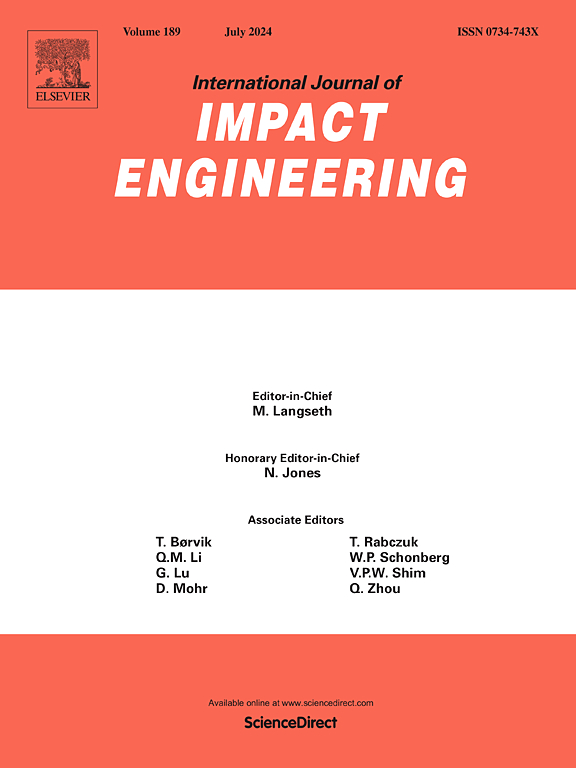考虑轴对称、应变速率依赖和损伤软化的SHPB试验和周动力模拟研究了水泥浆体圆柱体的散裂断裂
IF 5.1
2区 工程技术
Q1 ENGINEERING, MECHANICAL
International Journal of Impact Engineering
Pub Date : 2025-06-30
DOI:10.1016/j.ijimpeng.2025.105458
引用次数: 0
摘要
采用劈裂霍普金森压杆(SHPB)系统对水泥砂浆圆柱体的散裂断裂进行了实验研究,这是分析材料在中、高应变率下动态力学性能和动态断裂行为的关键技术。水泥基材料的散裂模拟需要进一步补充和使用改进的周动力学(PD)建模,该方法在模拟自发不连续演化方面具有独特的优势。具体而言,利用周期动力学微分算子(PDDO)建立了空间轴对称问题的非局部积分模型,该模型可归类为非普通基于状态的周期动力学(NOSB PD)模型;然后,进一步引入非球面影响函数(NSIF),以提高其数值精度和稳定性,特别是在波传播分析中。本文对静轴对称变形和动轴对称变形实例,即厚壁圆柱体受内压作用和波在细长圆柱体中的传播进行了高精度和稳定的数值模拟。此外,介绍了一种改进的基于键的周动力学(BB PD)模型,用双线性本构模型取代了原型微弹性脆性(PMB)本构模型。在此基础上,建立了一种准确、鲁棒的模拟SHPB冲击试验的周动力方法,并通过无试件SHPB系统中的波传播进行了验证。随后,采用基于粘结和轴对称的周动力学公式,对不同冲击速度下水泥砂浆柱体的SHPB冲击碎裂进行了数值模拟。对比分析了剥落飞片的长度和飞行速度以及实验和仿真得到的应变历史曲线,表明围动力学可以有效地模拟冲击剥落现象。本文章由计算机程序翻译,如有差异,请以英文原文为准。
Spallation fracture of cement paste cylinder by SHPB experiment and peridynamic simulation incorporating axisymmetry, strain-rate dependency and damage softening
The spallation fracture of cement mortar cylinders is experimentally investigated using a Split Hopkinson pressure bar (SHPB) system, which is a crucial technique for analyzing the dynamic mechanical properties and dynamic fracture behavior of materials at medium and high strain rates. The spallation simulation of cement-based materials requires further supplementation and modeling using improved peridynamics (PD), which possesses unique advantages in simulating spontaneous discontinuity evolution. Specifically, the peridynamic differential operator (PDDO) is employed to establish an integral nonlocal model for spatial axisymmetric problems, which can be categorized as a non-ordinary state-based peridynamic (NOSB PD) model; then, the non-spherical influence function (NSIF) is further incorporated to enhance its numerical accuracy and stability, particularly in wave propagation analysis. Both static and dynamic axisymmetric deformation examples, i.e., a thick-walled cylinder subjected to inner pressure and the wave propagation in a slender cylinder, are numerically simulated with high accuracy and stability. Additionally, an improved bond-based peridynamics (BB PD), replacing the prototype micro-elastic brittle (PMB) constitutive model with a bilinear constitutive model, is introduced. On this basis, an accurate and robust peridynamic approach for simulating the SHPB impact test is established and validated by the wave propagation in the SHPB system without a specimen. Subsequently, both bond-based and axisymmetric formulations of peridynamics are adopted to simulate the SHPB impact spallation of cement mortar cylinders under different striker velocities. The length and flying velocity of the spalling flyer and the strain history curve obtained from experiments and simulations are compared and analyzed, demonstrating that peridynamics can effectively model the impact spallation phenomenon.
求助全文
通过发布文献求助,成功后即可免费获取论文全文。
去求助
来源期刊

International Journal of Impact Engineering
工程技术-工程:机械
CiteScore
8.70
自引率
13.70%
发文量
241
审稿时长
52 days
期刊介绍:
The International Journal of Impact Engineering, established in 1983 publishes original research findings related to the response of structures, components and materials subjected to impact, blast and high-rate loading. Areas relevant to the journal encompass the following general topics and those associated with them:
-Behaviour and failure of structures and materials under impact and blast loading
-Systems for protection and absorption of impact and blast loading
-Terminal ballistics
-Dynamic behaviour and failure of materials including plasticity and fracture
-Stress waves
-Structural crashworthiness
-High-rate mechanical and forming processes
-Impact, blast and high-rate loading/measurement techniques and their applications
 求助内容:
求助内容: 应助结果提醒方式:
应助结果提醒方式:


